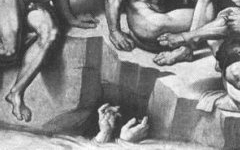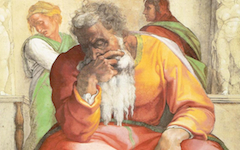Michelangelo’s Christ in the Last Judgment (1534-41)

Michelangelo, Detail of Christ in the Last Judgment (1536-41) Mural. Sistine Chapel, Vatican
Click image to enlarge.
There are many curiosities in Michelangelo's earth-shattering achievement in the Last Judgment. One of them, as Omar Calabrese has noted, is Christ's right hand. The most natural position for it would have been for the back of the hand to be facing the viewer.1 Michelangelo's decision to have the palm face us instead is highly significant, especially as Christ is the largest and most important figure in the composition.
Click next thumbnail to continue

L: Detail of Mary Magdalene in Titian's Pietà
R: Detail of Ariadne in Titian's Bacchus and Ariadne
Click image to enlarge.
I recently showed how two striding figures in Titian's paintings use the open palm facing away to indicate that they are "painting" the composition, their hand placed flat on the face of an invisible mirrror, a symbol for the artist's own mind. You can find other examples under the theme, Pointing and Touch.
Click next thumbnail to continue

Top: Detail of Christ's hand in Michelangelo's Last Judgment
Bottom: Detail of God's hand in God Separating the Waters from the Firmament
Click image to enlarge.
Calabrese claims that Michelangelo depicted the same hand four different times in the Sistine Chapel and that its cartography "perfectly expresses the artist's Saturnine nature" according to a treatise on palmistry published in Bologna while the artist was there. "It's always the same hand", Calabrese writes, "recognizable by the lines, the shapes, the contours and even the wrinkles." It is, of course, the artist's hand just as the open hands in Titian's paintings are too. Michelangelo even compared himself to the prophet Benjamin in his letters, a name which in Hebrew means "Hand of God."2
Click next thumbnail to continue
So, what does this all mean? I have shown elsewhere how the central composition of the Last Judgment is based on the head and profile of Dante with Christ in the center of the poet's mind (see diagram at left).3 Now it appears that the figure of the resurrecting Christ is Michelangelo himself, an identification which strengthens the theory: Dante reborn as Michelangelo. Indeed if while looking at the figure of Christ you switch on your imagination you should just be able to see......
Click next thumbnail to continue
....that Christ, halfway through a stride, might alternatively be just getting up from a stool in order to paint with his hand the very wall we are looking at. With his hand flat against the surface of the painting, Christ could "metaphorically" be in Michelangelo's own position, his other arm choosing paint from a palette.4 As in other masterpieces by other artists, the surface of Michelangelo's Last Judgment is an invisible mirror, the surface of the painter's own mind.5 It is a cardinal principle of esoteric Christianity that those who are capable should aim to perfect the divinity inside their own soul so that, once perfected, they too can become Christ as Michelangelo has done here. It is, like innumerable great masterpieces, an example for us all to follow.
See also my post on how the whole chapel is a self-representation of the artist: Michelangelo's Skull.
More Works by Michelangelo
How a drowning man in the Battle of Cascina has the hands of the artist

Michelangelo’s Hands in The Battle of Cascina (1504)
Notes:
1. Calabrese, Artists' Self-Portraits (New York: Abbeville Press) 2006, p.364
2. idem., p. 364
3. See Abrahams, A Quick Guide to the Sistine Chapel (2011) or a more comprehensive analysis in Abrahams, Michelangelo's Art Through Michelangelo's Eyes (2006).
4. I have already shown that several of the figures of God on the ceiling of the Sistine Chapel, in the so-called Creation panels, are also in the pose of Michelangelo himself in the act of painting. See Abrahams, "Michelangelo's Art Through Michelangelo's Eyes" (2006) Pt. 2, pp. 6-9
5. The two best known examples explained on this site are Titian's Pietà and Velazquez's Las Meninas.
Original Publication Date on EPPH: 31 Mar 2012. | Updated: 0. © Simon Abrahams. Articles on this site are the copyright of Simon Abrahams. To use copyrighted material in print or other media for purposes beyond 'fair use', you must obtain permission from the copyright owner. Websites may link to this page without permission (please do) but may not reproduce the material on their own site without crediting Simon Abrahams and EPPH.




